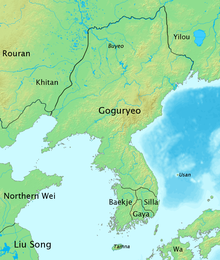കൊറിയയിലെ മൂന്ന് രാജ്യങ്ങൾ
സില്ല, ബീക്ജെ[1] , ഗോഗുര്യോ[2][3][4] [5][6][7][8][9] എന്നിവയെ ചേർത്താണ് കൊറിയയിലെ മൂന്ന് രാജ്യങ്ങൾ എന്ന് വിവക്ഷിക്കപ്പെടുന്നത് (Three Kingdoms of Korea Hangul: 삼국시대; Hanja: 三國時代).ഗോഗുര്യോ പിന്നീട് ഗോറിയോ (고려, 高麗) എന്നറിയപ്പെട്ടു, അതിൽ നിന്നാണ് കൊറിയ എന്ന ആധുനിക നാമം ഉരുത്തിരിഞ്ഞത്. മൂന്ന് രാജ്യങ്ങളുടെ കാലഘട്ടം ബിസി 57 മുതൽ എഡി 668 വരെ ആയിരുന്നു.മൂന്ന് രാജ്യങ്ങളും കൊറിയയുടെ മുഴുവൻ ഉപദ്വീപും മഞ്ചൂറിയയുടെ പകുതിയും ഭരിച്ചിരുന്നു. ബെയ്ക്ജെ, സില്ല എന്നീ രാജ്യങ്ങൾ കൊറിയൻ ഉപദ്വീപിന്റെ തെക്കൻ പകുതിയിലും തംനയിലും (ജെജു ദ്വീപ്) ആധിപത്യം സ്ഥാപിച്ചു, അതേസമയം ഗോഗുരിയോ ലിയോഡോംഗ് പെനിൻസുല, മഞ്ചൂറിയ, കൊറിയൻ പെനിൻസുലയുടെ വടക്കൻ പകുതി എന്നിവ നിയന്ത്രിച്ചു. 3-ആം നൂറ്റാണ്ടിൽ ഇന്ത്യയിൽ നിന്ന് ടിബറ്റ്, ചൈന വഴി കൊറിയയിൽ എത്തിയ ബുദ്ധമതം, മൂന്ന് രാജ്യങ്ങളിലെയും ഔദ്യോഗികമതമായി മാറി.[10]
| കൊറിയയിലെ മൂന്ന് രാജ്യങ്ങൾ | |
 | |
| Korean name | |
|---|---|
| Hunminjeongeum | |
| Hanja | |
| Revised Romanization | Samguk-sidae |
| McCune–Reischauer | Samguk-sidae |
| Other name | |
| Hunminjeongeum | |
| Hanja | |
| Revised Romanization | Samguk-sigi |
| McCune–Reischauer | Samguk-sigi |
ഏഴാം നൂറ്റാണ്ടിൽ, താങ് രാജവംശത്തിന്റെ ഭരണത്തിലായിരുന്ന ചൈനയുമായി സഖ്യത്തിലേർപ്പെട്ട സില്ല, കൊറിയൻ ചരിത്രത്തിൽ ആദ്യമായി കൊറിയൻ ഉപദ്വീപിനെ ഏകീകരിച്ചു. ബെയ്ക്ജെ, ഗോഗുരിയോ എന്നിവയുടെ പതനത്തിനുശേഷം, കൊറിയൻ ഉപദ്വീപിന്റെ ചില ഭാഗങ്ങൾ ഭരിക്കാൻ ടാങ് രാജവംശം ഒരു ഹ്രസ്വകാല സൈനിക ഭരണകൂടം സ്ഥാപിച്ചു. എന്നിരുന്നാലും, സില്ല-താങ് യുദ്ധത്തിന്റെ (≈670-676 എ.ഡി) ഫലമായി, 676-ൽ സില്ല സൈന്യം സൈനിക ഭരണകൂടത്തെ ഉപദ്വീപിൽ നിന്ന് പുറത്താക്കി.
തുടർന്ന്, മുൻ ഗോഗുർയോ ജനറൽ[11] സുമോ മോഹെയുടെ തലവൻ[12][13] ബൽഹെയിലെ ഗോ ടിയാൻമെൻലിംഗ് യുദ്ധത്തിൽ ടാങ് രാജവംശത്തെ പരാജയപ്പെടുത്തിയ ശേഷം ഗോഗുരിയോയുടെ മുൻ പ്രദേശത്ത് ബൽഹെ സ്ഥാപിച്ചു. ഇതിനു ശേഷം, സമ്പൂർണ്ണ രാജ്യങ്ങളുടെ വികാസത്തിന് മുമ്പുള്ള കാലഘട്ടത്തെ ചിലപ്പോൾ പ്രോട്ടോ-മൂന്ന് രാജ്യങ്ങളുടെ കാലഘട്ടം എന്ന് വിളിക്കുന്നു.
ഈ കാലയളവിലെ പ്രധാന പ്രാഥമിക ചരിത്രസ്രോതസ്സുകളിൽ കൊറിയയിലെ സാംഗുക് സാഗിയും സാംഗുക് യുസയും, ചൈനയിലെ ചെൻ ഷൗ എഴുതിയ റെക്കോർഡ്സ് ഓഫ് ത്രീ കിംഗ്ഡംസിലെ ബുക്ക് ഓഫ് വെയ്ൽ(魏書) നിന്നുള്ള കിഴക്കൻ കിരാതന്മാർ("Eastern Barbarians" 東夷傳) എന്ന വിഭാഗവും ഉൾപ്പെടുന്നു.
മതം
തിരുത്തുകബുദ്ധമതം ഇന്ത്യയിൽ ഉത്ഭവിച്ച് നൂറ്റാണ്ടുകൾക്ക് ശേഷം, മഹായാന ബുദ്ധമതം 1-ആം നൂറ്റാണ്ടിൽ ടിബറ്റ് , സിൽക്ക് റൂട്ട് വഴി ചൈനയിൽ എത്തി, തുടർന്ന് 3-ആം നൂറ്റാണ്ടിൽ കൊറിയൻ ഉപദ്വീപിലേക്കും മൂന്ന് രാജ്യങ്ങളുടെ കാലഘട്ടത്തിൽ അത് ജപ്പാനിലേക്കും വ്യാപിച്ചു. കൊറിയയിൽ, മൂന്ന് രാജ്യങ്ങളുടെ കാലഘട്ടത്തിലെ 3 ഘടക രാഷ്ട്രങ്ങൾ ബുദ്ധമതത്തെ ഔദ്യോഗിക മതമായി അംഗീകരിച്ചു. ആദ്യമായി 372-ൽ ഗ്യൂംഗ്വാൻ ഗയയിലെ ഗോഗുരിയോ ഭരണ ഗോത്രവും, 528-ൽ സില്ലയും, 552-ൽ ബെയ്ക്ജെയും ബുദ്ധമതത്തെ ഔദ്യോഗിക മതമായി അംഗീകരിച്ചു. [10]
അവലംബം
തിരുത്തുക- ↑ Ebrey, Patricia Buckley; Walthall, Anne; Palais, James B. (2006). East Asia: A Cultural, Social, and Political History (in ഇംഗ്ലീഷ്). Houghton Mifflin. p. 123. ISBN 9780618133840. Retrieved 12 September 2016.
- ↑ Roberts, John Morris; Westad, Odd Arne (2013). The History of the World (in ഇംഗ്ലീഷ്). Oxford University Press. p. 443. ISBN 9780199936762. Retrieved 15 July 2016.
- ↑ Gardner, Hall (2007-11-27). Averting Global War: Regional Challenges, Overextension, and Options for American Strategy (in ഇംഗ്ലീഷ്). Palgrave Macmillan. pp. 158–159. ISBN 9780230608733. Retrieved 15 July 2016.[പ്രവർത്തിക്കാത്ത കണ്ണി]
- ↑ Laet, Sigfried J. de (1994). History of Humanity: From the seventh to the sixteenth century (in ഇംഗ്ലീഷ്). UNESCO. p. 1133. ISBN 9789231028137. Retrieved 10 October 2016.
- ↑ "Koguryo". Encyclopædia Britannica. Retrieved October 15, 2013.
- ↑ Barnes, Gina (2013). State Formation in Korea: Emerging Elites.
- ↑ Byington, Mark (2016). The History and Archaeology of the Koguryo Kingdom.
- ↑ Li, Narangoa; Cribb, Robert (2014). Historical Atlas of Northeast Asia.
- ↑ Gardiner, Kenneth (1964). The origin and rise of the Korean kingdom of Koguryo, from the 1st century to A.D. 313 (PhD). University of London.
- ↑ 10.0 10.1 Lee Injae, Owen Miller, Park Jinhoon, Yi Hyun-Hae, 2014, Korean History in Maps, Cambridge University Press, pp. 44-49, 52-60.
- ↑ Vovin, Alexander (2006). "Why Manchu and Jurchen Look so Un-Tungusic ?". In Juha Janhunenn; Alessandra Pozzi; Michael Weiers (eds.). Tumen jalafun jecen akū: Festschrift for Giovanni Stary's 60th birthday. Harrassowitz. pp. 255–266.
- ↑ Richard, Zgusta (2015). The Peoples of Northeast Asia through Time Precolonial Ethnic and Cultural Processes along the Coast between Hokkaido and the Bering Strait. ISBN 978-90-04-30043-9.
- ↑ Tsiporuha Mikhail Isaakovich (2017). "История тунгусских племен мохэ и государства Бохай" [The history of Mohé and Bohai Tungusic tribes]. Покорение Сибири. От Ермака до Беринга. Archived from the original on 2021-06-13. Retrieved 2021-04-18.